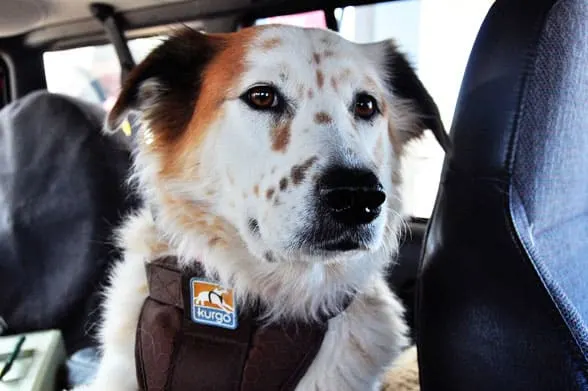 Many dogs love to go riding in the car with their pet parents (most cats are another story!) But whether you are traveling for pleasure or by necessity (like taking a pet to the vet’s office) there are a few things to consider before you hit the road.
Many dogs love to go riding in the car with their pet parents (most cats are another story!) But whether you are traveling for pleasure or by necessity (like taking a pet to the vet’s office) there are a few things to consider before you hit the road.
Below, in “The Caring Vet Column,” Dr. Jeff Werber lists ten tips to make sure that you and your pet ride in comfort and safety.
 Tip #1:
Tip #1:
Always keep a pet restrained in a car—either with a harness that attaches to a seat belt, or a pet carrier that can be anchored in a seat belt. Pets running freely in a car are at risk, and so is the driver, either by being distracted or by the pet looking for safety by the driver’s feet by the brake or gas pedal.
Tip #2:
Best to acclimate a pet to car rides slowly—and always making the experience a positive one with plenty of praise and treats. At first, take your pet into the car, strap him in, start the engine, count to 10, then turn the engine off, take your pet out of the car, and give lots of praise and a treat. Slowly increase the acclimation time, than after 3 to 4 minutes is mastered, take your first short trip (around the block), then give the same praise and rewards. The key is to make the process fun and not frightening.
Tip #3:
Since dogs or cats that suffer from a gastro-intestinal upset do so more because of the anxiety than because of motion sickness, medications or supplements geared to “calming” are usually more effective than those for motion. Check with your veterinarian before giving any kind of medication.
Tip #4:
For long trip, make sure to take plenty of bathroom-break stops.
Tip #5:
When stopping, make sure to connect the leash to your pet’s collar BEFORE opening a car door. Pets in strange locations may bolt out of the car door if given the chance
Tip #6:
For cats, a small traveling litter box is a good idea to have in the car.
Tip #7:
Since dogs have sensitive GI tracts, and don’t do well with change, before a trip, we recommend filling a large gallon jug with your local water. At every stop, if water was consumed, fill the jug back to the top with local water—don’t wait for it to empty. This way, water from new water supplies will be gradually introduced—always mixing with your own water supply.
Tip #8:
Though sometimes tempting, NEVER leave your pet in a parked car-even with the windows cracked open. A parked car with a panting, nervous dog inside can get very hot, very quickly.
Tip #9:
Bring a few extra towels with you to use for clean up—just in case………
Tip #10:
Always carry a picture of your pet with you, all vaccine information, any special medication (including a backup supply in case your trip home gets delayed), and make sure your pet has adequate identification (I.D. tags and a microchip). Better safe than sorry!
With proper planning and preparedness, traveling with your pets can be fun, enjoyable, and hassle-free!
-Dr. Jeff Werber, Pro-Sense Premium Pet Products
About the Author: To learn more about Dr. Jeff, visit www.drjeff.com. Follow along with what’s new with Dr. Jeff on his Facebook page and @drwerber Twitter account, too!
- Selecting the Best Online Emotional Support Animal Letter Service - December 14, 2023
- How to Store Dog Toys –10 Solutions to Organize Those Toys! - July 7, 2022
- Best Practices to Puppy-Proof Your Home - June 27, 2022
